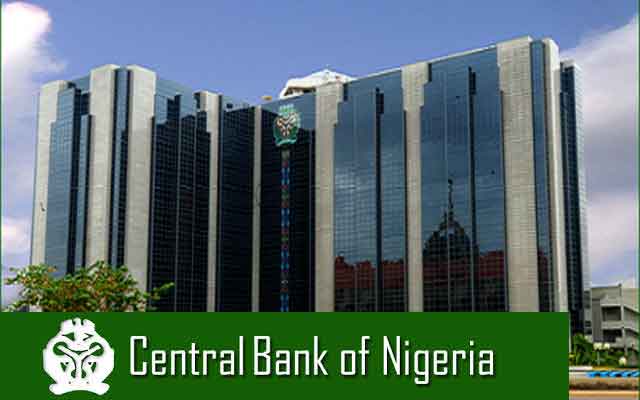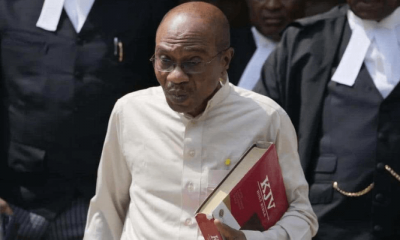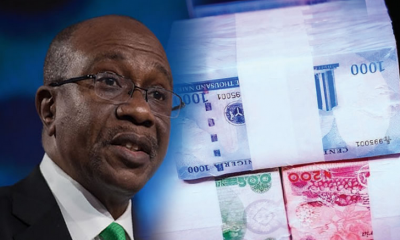Business
Global Bank Crisis: An Alert for Nigerian Banks?
Published
1 year agoon
By
Marcel Okeke
By Marcel Okeke
Unsurprisingly, the Monetary Policy Committee (MPC) of the Central Bank of Nigeria (CBN) after its meeting on Tuesday, 21 March 2023, opened its communique (Number 147) with an acknowledgement of the ‘serial’ bank failures and turmoil in the global financial system.
The MPC said it is faced with “new and existing headwinds, undermining the full recovery of the global economy. These include the recent bank failures in the United States and Switzerland, amidst widespread monetary policy tightening, which introduced a new dimension to the risks confronting the global financial system…”
The MPC further noted that “the continued hostilities between Russia and Ukraine and its implications to the smooth functioning of the global supply chain also remain a critical strain to the recovery of global output growth.”
Related: Cash crisis: investors dump banking, insurance stocks amid fears
Certainly, since March 2023, there has been palpable tension in the global financial space—founded on crisis which magnitude and timespan is yet indeterminate. Already, major central banks across the globe are taking collaborative and proactive initiatives to stymie the snowballing crisis.
Prices of commodities such as crude oil, gold and others are already being affected—either negatively or positively. Specifically, the US Federal Reserve and several other major central banks have announced a coordinated effort (March 19) to boost the flow of US dollars through the global financial system with the aim of keeping credit flowing to households and businesses, according to CNN report.
“The Bank of Canada, the Bank of England, the Bank of Japan, the European Central Bank (ECB), the Federal Reserve, and the Swiss National Bank are today (March 19) announcing a coordinated action to enhance the provision of liquidity via the standing US dollar liquidity swap line arrangements,” the central banks said in a joint statement.
Related: Fraudsters becoming more creative — NDIC warns bank customers
Indeed, in the past couple of weeks, a number of financial institutions have been “going under”. First was the collapse of crypto lender, Silvergate last Thursday (March 16); second was Silicon Valley Bank (SVB) on Friday (March 17) and New York-based Signature Bank on Sunday (March 19). The impact of all these however got accentuated by the unravelling of the crippling challenges of Switzerland’s second biggest lender, Credit Suisse—a development that further sent panic across the global financial system in a manner akin to the onset of the 2008/9 financial meltdown.
The case of the Suisse Bank became more telling and frightening, given the size and place of the lender over the decades. Additionally, its problems are also relatively unique and not new, “with a string of major financial losses and scandals that have worried investors and fuelled a recent client exodus”, according to reports.
While it might not be most apposite here to explore details of the causes of the failure of each of the (affected) banks, it is strongly believed that their huge exposure to Criptocurrency transactions/clients and crippling high interest rates largely ruined them. Credit Suisse customers – primarily wealthy clients and businesses rather than everyday savers – have been pulling money from the bank for months, leading to more than 111billion Swiss francs (£100 billion) of outflows late last year.
It was not immediately clear on Wednesday (15 March) whether client withdrawals had gathered pace as a result of its plunging share price. However, it was obvious that Credit Suisse — one of the 30 most important banks in the global financial system — was bleeding money after investor and customer confidence collapsed.
According to the CNN, market turmoil triggered by the second (SVB) and third biggest bank (Signature Bank) failures in US history earlier this month (March) was threatening to make it harder for people to borrow money, US Treasury Secretary Janet Yellen reportedly said last week. “If banks are under stress, they might be reluctant to lend,” Yellen said Thursday (16 March) in testimony to the Senate Finance Committee.
“We could see credit become more expensive and less available.” Christine Lagarde, president of the European Central Bank (ECB), on her part told reporters same Thursday that “persistently elevated market tensions” could further constrict credit conditions that were already tightening in response to rising interest rates.
Related: Building a Thriving Global Brand for the Diverse African Market
And this is where and why the US dollar liquidity swap line adoption became imperative. Swap lines are agreements between two central banks to exchange currencies. They allow a central bank to obtain foreign currency from the central bank that issues it, and distribute it to commercial banks in their country. The swap line between US Federal Reserve and the ECB, for example, enables the ECB to receive US dollars in exchange for an equivalent amount of euros.
The ECB can then distribute those dollars to commercial banks in the 20 countries that use the euro. In the circumstance, resorting to the agreements can be an important tool for preserving financial stability and preventing market tension from further affecting the Euro-economy, according to the ECB.
It will be recalled that during the global financial crisis of 2008/9 following the collapse of Lehman Brothers, funding markets dried up because of an extreme aversion to risk by lenders. Under these circumstances it became difficult for euro area banks to obtain US dollars at that time. In the emerging situation therefore, the major central banks are collaborating to ensure that “the Fed and other central banks would make dollars available on a daily basis, rather than weekly.
“The network of swap lines among these central banks is a set of available standing facilities and serve as an important liquidity backstop to ease strains in global funding markets, thereby helping to mitigate the effects of such strains on the supply of credit to households and businesses,” the apex banks added.
Juxtaposing this swap initiative by the developed nations’ apex banks to stem the financial crisis with the decisions of the CBN’s MPC, leaves the Nigerian economy to an assortment of vulnerabilities and avoidable headwinds.
Some of the key decisions taken by the MPC (communique Number 147) include raising the Monetary Policy Rate (MPR) by 50 basis points to 18.0 per cent, retaining Cash Reserve Ratio (CRR) at 32.5 per cent, among others. Curiously, the key reason by the MPC for raising the MPR was to help in checkmating the surging inflation (standing at 22% at end-February, 2023).
But truly, hiking MPR automatically leads to more soaring interest rates (especially lending) in the Nigerian economy. That is, putting credit practically beyond the reach of a large chunk of businesses and the consumer. Ironically, while the US Treasury Secretary Janet Yellen and the ECB boss, Christine Lagarde are working hard to ensure that credit does not become more expensive and less available to economic agents, the new MPR appears to indicate the opposite scenario in Nigeria.
Specifically, Lagarde warned that “persistently elevated market tensions” could further constrict credit conditions that were already tightening in response to rising interest rates.
Related: Politics, Economics and Nigeria’s Trudging Economy
In point of fact, does hiking of MPR ‘fight’ inflation? No, it doesn’t, especially in the Nigeria kind of economy where foreign exchange issues and high import-dependency subsist. Imported inflation and certain socio-environmental factors in Nigeria are certainly outside the purview of the MPC. Already, the failure of some banks just this month (March 2023), has been impacting the prices of oil and other commodities.
For instance, oil prices fell on Monday (March 20) to their lowest in 15 months on concerns that risks in the global banking sector may cause a recession that would lead fuel demand to decline and ahead of a potential hike in U.S. interest rates soon. On the other hand, gold prices edged higher on Tuesday (March 21), with investors looking forward to the Federal Reserve policy meeting as expectations grew that the U.S. central bank would slow its monetary policy tightening given the upheaval in the banking sector. Gold is considered a safe haven during times of financial uncertainty, and lower interest rates make non-yielding bullion more attractive by reducing the opportunity cost of holding it.
According to Reuters, in volatile trading on Monday (March 20), gold prices initially fell by one percent, but reversed course to jump to their highest since March 2022 at US$2,009.59, “as investors digested the impact of measures taken by several central banks to contain a banking crisis and stabilise global financial markets.”
For Nigeria, the MPC’s 32.5 per cent CRR does not give the deposit money banks (BMBs) much elbowroom to harbour resources for improved lending to the public. It rather leaves the apex bank with so much chunk of bank deposits to be ‘sterilized’ in their vaults or to be giving in trillions to the Federal Government under ‘Ways and Mean’.
DBMs only make so much from commissions and charges to the displeasure of their customers. All these add to the pangs of the paucity of cash in circulation in the ongoing naira redesign policy and adjunct initiatives. The MPC’s reckoning with the unpredictability of developments around the Russia-Ukraine war as the year unfolds further obfuscates the outlook of Nigeria and its financial system, should the banking crisis fester. What immunity has Nigeria in the fast-spreading crisis, as a key member of the ‘global village’?
- Mr. Okeke, an economist, sustainability expert and consultant on business strategy is a Columnist with National Daily. He can be reached at: [email protected]
You may like


Nigerian Economic Summit Group calls for registration for NESG 2024 Macroeconomic Outlook Launch


CBN Investigator highlights Emefiele’s gross financial offences


Court grants Emefiele bail


Some extremely wealthy Nigerians had CBN in their pockets – Shehu Sani


Emefiele’s Naira redesign policy responsible for currency’s scarcity–Falana


No plea bargain with Emefiele — AGF
Trending

 Health & Fitness4 days ago
Health & Fitness4 days agoMalaria Vaccines in Africa: Pastor Chris Oyakhilome and the BBC Attack

 Featured1 week ago
Featured1 week agoPolice reportedly detain Yahaya Bello’s ADC, other security details

 Aviation6 days ago
Aviation6 days agoWhy some airlines are avoiding Nigeria’s airspace–NAMA

 Aviation5 days ago
Aviation5 days agoJust in: Dana airline crash lands in Lagos

 Aviation4 days ago
Aviation4 days agoNSIB begins investigation into Dana Air after crash-landing incident

 Business1 week ago
Business1 week agoDebt servicing gulps 56% of Nigeria’s tax revenue, says IMF

 Business1 week ago
Business1 week agoAdesola Adeduntan steps down as FirstBank CEO

 News1 week ago
News1 week agoOndo APC guber hopefuls reject primary poll

